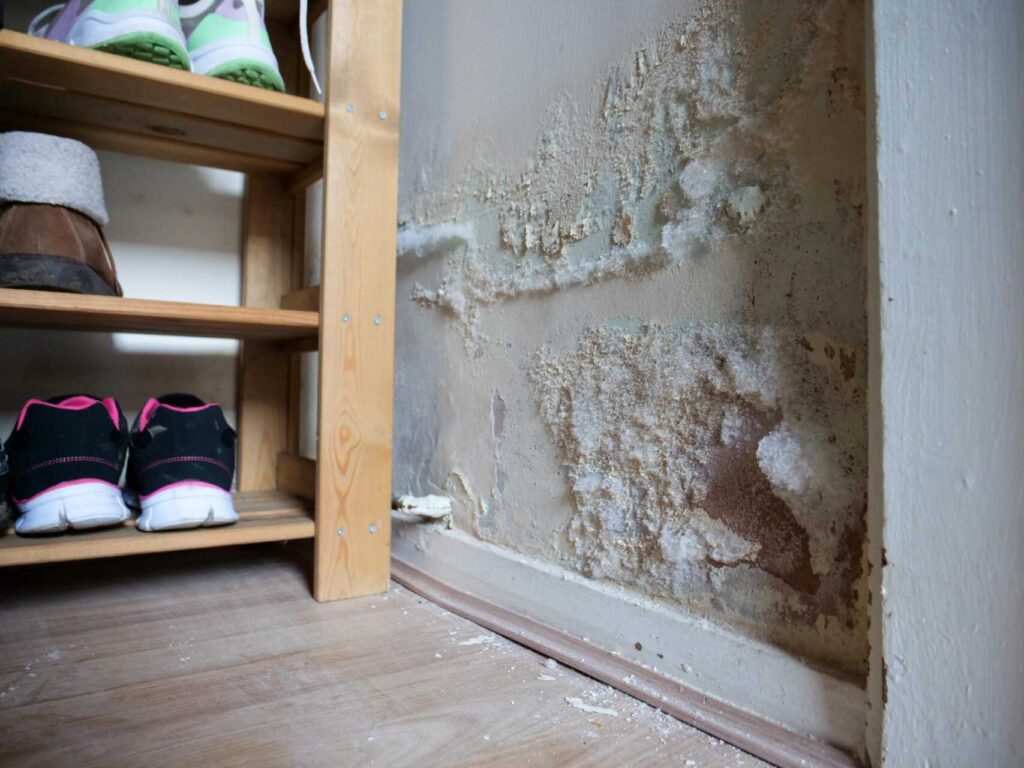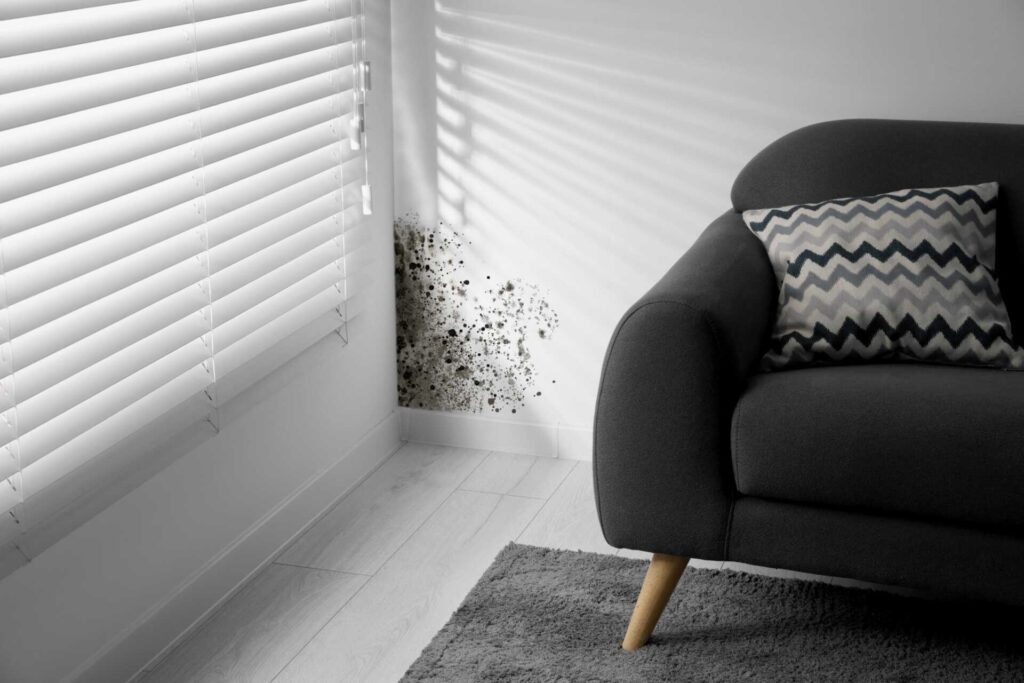
Contents
Have you ever considered how mold could be silently threatening your home? Understanding essential mold remediation strategies is vital for every homeowner. This quiz tests your knowledge and equips you with practical techniques to identify, prevent, and address mold issues effectively. By exploring the intricacies of mold growth and remediation, you can establish a safer living environment—so what steps will you take to safeguard your home?
Key Takeaways
- Identify visible mold growth and musty odors to assess the extent of mold infestation in your home.
- Wear appropriate personal protective equipment (PPE) to ensure safety during mold remediation efforts.
- Use a mixture of water and detergent for surface mold removal, testing solutions on small areas first.
- Seal off affected areas with plastic sheeting to prevent mold spores from spreading during cleanup.
- Maintain low humidity levels below 60% and ensure proper ventilation to prevent future mold growth.
Understanding Mold Growth and Its Risks
Although mold is a natural part of our environment, it can pose serious health risks when it grows indoors. Understanding how mold thrives is vital for maintaining a safe home.
Mold spores thrive in damp, warm conditions, often found in areas like bathrooms and basements. When humidity levels rise above 60%, you increase the chances of mold growth.
Exposure to mold can lead to respiratory issues, allergic reactions, and other health concerns, especially for those with pre-existing conditions. Identifying the right conditions that encourage mold growth helps you take proactive steps to mitigate risks.
Maintaining good ventilation, controlling humidity, and promptly addressing leaks are essential strategies for prevention.
When you recognize the environmental factors that contribute to mold, you empower yourself to create a healthier living space. Remember, understanding mold remediation isn’t just about knowledge; it’s about fostering a safe environment for you and your loved ones.
Identifying Common Signs of Mold Infestation
When checking for mold in your home, look for visible growth, which can appear as black, green, or white patches on surfaces.
You should also pay attention to musty odors, as they often indicate hidden mold.
Identifying these signs early can help you address the problem before it escalates.
Visible Mold Growth
Identifying visible mold growth in your home is essential for addressing potential health risks and property damage. Mold can appear in various forms and colors, often thriving in damp areas. Look for these common signs to help detect an infestation:
| Mold Type | Appearance | Common Locations |
|---|---|---|
| Powdery | White or gray powdery spots | Walls, ceilings |
| Fuzzy | Green, brown, or black patches | Bathrooms, kitchens |
| Slimy | Wet, shiny surfaces | Leaky pipes, basements |
| Spotty | Small, round dots | Behind furniture, corners |
Regularly inspect these areas, and don’t ignore visible mold. The sooner you identify and address it, the better you protect your home and your health.
Musty Odor Detection
A musty odor in your home often signals hidden mold growth, making it vital to investigate further. This scent typically resembles damp, earthy smells and can be more pronounced in areas with excess moisture, such as basements, bathrooms, or kitchens.
Trust your nose; if you detect this odor, you may have mold lurking behind walls or under flooring.
To pinpoint the source, check for water leaks, condensation, or humidity issues. Inspect hidden corners, crawl spaces, and ventilation systems, as these places often harbor mold.
Assessing the Scope of Mold Damage
Though mold might seem like a minor issue at first, evaluating the scope of mold damage is crucial for effective remediation. Start by identifying visible mold growth in areas like walls, ceilings, and under sinks. Pay attention to darker spots, irregular textures, or water stains that might indicate underlying problems.
Next, assess the extent of moisture. Check for leaks, condensation, or high humidity levels, as these are often the root causes of mold growth. Use a moisture meter to gauge dampness in materials like wood and drywall.
Don’t forget to inspect hidden areas, such as behind appliances or inside crawl spaces, where mold may thrive unnoticed. Document your findings with photos and notes, as this information will be invaluable when seeking professional help or determining the necessary remediation steps.
Taking these measures ensures you fully understand the situation before taking action, fostering a healthier living environment for you and your family.
Safety Precautions for Mold Remediation
Once you’ve assessed the scope of mold damage, prioritizing safety during remediation is essential.
Start by wearing appropriate personal protective equipment (PPE), including gloves, goggles, and an N95 respirator. This gear helps protect you from inhaling mold spores and direct contact with contaminated surfaces.
Ensure proper ventilation in the affected area by opening windows and using fans to circulate air.
If the mold covers a large area, consider sealing off the space with plastic sheeting to prevent spores from spreading to other parts of your home.
It’s also a good idea to turn off your HVAC system to avoid circulating mold throughout your home.
Finally, be aware of your health. If you experience any respiratory issues, headaches, or irritation, it’s best to stop work and consult a professional.
Effective Cleaning Solutions for Mold Remediation
When tackling mold removal, choosing the right cleaning solutions is essential for effectiveness and safety. Common options include a mixture of water and detergent, which can effectively eliminate surface mold.
For tougher infestations, consider using a solution of vinegar and water or a bleach solution—though be cautious, as bleach can release harmful fumes and damage some surfaces.
Always test a small area first to ensure compatibility.
Commercial mold remediation is also available; just make sure they’re EPA-approved and safe for indoor use.
Proper Ventilation Techniques to Prevent Mold
To effectively prevent mold growth in your home, you need to focus on proper ventilation techniques.
Managing airflow and controlling humidity are essential strategies in maintaining a dry environment.
Airflow Management Strategies
Effective airflow management is essential for preventing mold growth in your home, as stagnant air creates the perfect breeding ground for spores.
By implementing proper ventilation techniques, you can greatly speed up mold remediation. Here are four strategies to enhance airflow:
Open windows regularly – Allow fresh air to circulate and replace stale air.
Use exhaust fans – Install them in high-moisture areas like kitchens and bathrooms to expel humid air.
Maintain HVAC systems – Regularly clean and replace filters to ensure efficient air movement.
Create cross-ventilation – Position fans to direct airflow across rooms, especially in tight spaces.
Humidity Control Methods
Although managing humidity levels might seem intimidating, implementing proper ventilation techniques can greatly reduce mold risks in your home.
Start by ensuring your kitchen and bathrooms are equipped with exhaust fans that vent outside. This simple step helps eliminate moisture generated from cooking and showering.
Additionally, consider using dehumidifiers in damp areas like basements to maintain ideal humidity levels below 60%.
Keep windows slightly open when weather permits to promote airflow, allowing fresh air to circulate and stale air to escape.
Regularly inspect and clean your HVAC system, ensuring that filters are changed as necessary.
Importance of Moisture Control in Mold Prevention
Moisture control is essential in preventing mold growth, as excessive humidity creates an ideal environment for spores to thrive.
By managing moisture levels in your home, you can greatly reduce the risk of mold infestations. Here are four key strategies to implement:
Regularly check for leaks in plumbing and roofing; even small drips can lead to big problems.
Use dehumidifiers in damp areas like basements; they help maintain optimal humidity levels.
Ventilate your home by opening windows and using exhaust fans; fresh air circulation is vital.
Insulate cold surfaces such as pipes and windows to prevent condensation from forming.
When to Call Professional Mold Remediation Services
How can you determine when it’s time to call in the experts for mold remediation? If you notice extensive mold growth—generally more than ten square feet—it’s a clear indication that you should seek professional help.
Mold can spread quickly and may pose health risks, especially for those with allergies or respiratory issues.
Additionally, if you can’t identify the source of moisture or if the mold persists after a DIY removal effort, calling in specialists is crucial. They have the tools and knowledge to address underlying issues, ensuring thorough remediation.
If you find mold in HVAC systems or walls, don’t hesitate to reach out to professionals. They can assess and manage these complex situations safely.
Trusting experts protects your home and fosters a sense of community, as you’re taking responsible steps to ensure a healthy living environment for yourself and your loved ones.
Long-Term Strategies for Mold Prevention
To effectively prevent mold in your home, focus on regular HVAC maintenance and moisture control techniques.
By ensuring your heating and cooling systems operate efficiently, you reduce humidity levels that foster mold growth.
Implementing simple moisture control strategies, like using dehumidifiers and sealing leaks, can further protect your living space.
Regular HVAC Maintenance
While regular HVAC maintenance might seem like a chore, it’s an essential strategy for mold prevention in your home. A well-maintained HVAC system helps control humidity levels and improves air quality, both vital for keeping mold at bay.
Here are four key steps you should follow:
Change air filters monthly to ensure proper airflow and reduce allergens.
Clean the ducts annually to eliminate dust and debris that can harbor mold spores.
Inspect the condensate drain regularly to prevent clogs that can lead to moisture buildup.
Schedule professional maintenance biannually to catch potential issues before they escalate.
Moisture Control Techniques
Moisture is the enemy of a healthy home, and controlling it is essential for preventing mold growth. Implementing effective moisture control techniques can greatly enhance your living environment. Here are some strategies to ponder:
| Technique | Description | Benefits |
|---|---|---|
| Ventilation | Use exhaust fans in kitchens/bathrooms | Reduces humidity and odors |
| Dehumidifiers | Keep humidity below 60% | Prevents mold and dust mites |
| Insulation | Insulate pipes and attics | Minimizes condensation |
| Water Management | Fix leaks and drainage issues | Protects structures and health |
| Landscaping | Slope soil away from the foundation | Prevents water accumulation |
Creating a Mold Remediation Action Plan for Your Home
Creating a mold remediation action plan for your home is essential, especially since timely intervention can prevent extensive damage and health risks.
By being proactive, you can ensure a safe environment for you and your loved ones. Here are four key steps to include in your plan:
Identify Vulnerable Areas: Regularly inspect basements, bathrooms, and kitchens for signs of moisture or mold.
Establish Moisture Controls: Utilize dehumidifiers and proper ventilation to reduce humidity levels.
Develop a Response Strategy: Know who to call—whether it’s a mold remediation expert or a trusted handyman—if you discover mold.
Educate Your Household: Share knowledge about mold remediation and response tactics with family members to ensure everyone is prepared.
Summary
By understanding mold growth and implementing effective remediation strategies, you’re protecting your home and safeguarding your sanctuary. Like a vigilant gardener tending to their plants, you can nurture a healthy environment by recognizing the signs of mold, controlling moisture, and knowing when to seek professional help. With a solid mold action plan in place, you’ll cultivate a resilient home that stands strong against the silent invader of mold, ensuring peace of mind for you and your loved ones.

